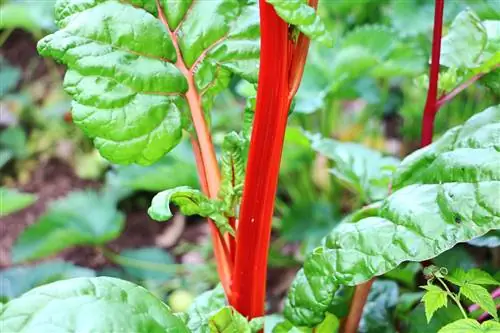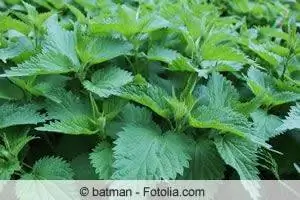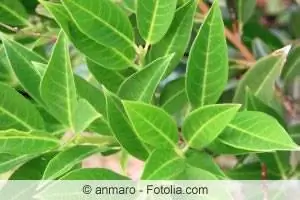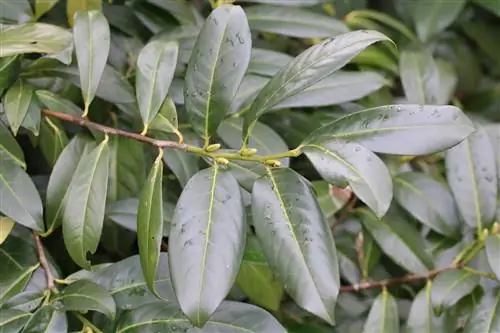- Author admin [email protected].
- Public 2023-12-17 03:39.
- Last modified 2025-01-24 12:45.
Laurel plants are interesting in appearance; their special, elongated leaves, their many small flowers, and their tightly upright growth make them unmistakable. The leaves are used for hearty broths, soups, braised and fish dishes. They are also ideal for sour and spicy marinades. You can let them steep briefly or cook them too. Since spice laurel is not reliably hardy, it is often cultivated as a container plant.
Spice laurel profile
- Laurus nobilis, also called real laurel
- Medicinal and spice plant
- Comes from the Near East
- Evergreen shrub or small tree
- Up to 10 m tall, with us usually only 1 to 3 m
- Leathery, shiny leaves with an aromatic scent
- Mostly separate sexes
- Flower color pale green-yellow
- Flowering period from March to April
- Black shiny berries
- Essential and fatty oils in the fruit
Care of spiced laurel
Caring for the spice laurel is unproblematic. It likes sun, needs it to produce enough essential oils and a location that is as sheltered from the wind as possible. Since the plants are usually grown in pots due to their often insufficient winter hardiness, you can easily place them in the appropriate place.
Location requirements
The location should be sunny to partially shaded at most. A place protected from the wind is also recommended.
- Sunny to partially shaded at most
- Protected from the wind
It is important that the plant substrate is very permeable. Drainage in the bottom of the pot also makes sense so that excess water can drain away. When planting outdoors, care must also be taken to ensure that the substrate is permeable and drained of water. Wet ground and frost can be fatal. Garden soil mixed with peat and sand has proven to be ideal. You can also add compost before planting, then you have fertilized straight away.
- Permeable
- Garden soil with peat and sand
- Drainage
Planting spice laurel
The best time to plant spice laurel is spring or autumn. In principle, container plants can also be purchased and planted in summer. When planting in a container, the first thing to think about is drainage in the bottom of the pot. It is important that the root ball is watered sufficiently before planting. It's best to place it in a bucket of water and wait until no more air bubbles appear, then the bale is really saturated. Place the plant in the prepared hole or container and fill in the soil. This must be pressed firmly. After planting, water properly again.
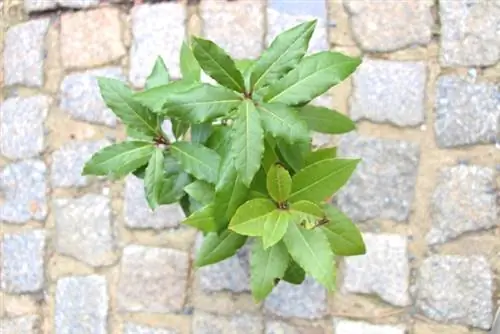
- Planting hole when planting about 80 x 80 cm
- Watering root balls
- Then insert and fill with soil
- A support post can be helpful. He will be used immediately.
Pouring
The spiced laurel doesn't really need a lot of water, but the soil shouldn't dry out. An evenly slightly moist substrate is ideal. In sunny locations, watering must therefore be carried out more often. Regular watering is particularly important for potted plants, because the soil in a container dries out quickly. It is crucial that watering is carried out thoroughly. This doesn't have to be done so often, but just small, superficial waterings aren't enough.
- Pour thoroughly
- Water regularly when keeping containers
- Calciferous water is not ideal, rainwater is better
Fertilize
The nutrient requirements of spiced laurel are rather low. Too much nitrogen causes excessive linear growth. The entire plant becomes out of shape. The leaf spacing is unnaturally large and the laurel no longer appears as compact as it actually does. If the strong green leaves lose their color and fade, this is usually due to a lack of nutrients.
Rather moderate nutrient requirements
Cutting
Spice laurel doesn't necessarily have to be cut. You actually only cut to get to the leaves. To do this, you cut out what is needed from the shoots. Larger pruning measures are best carried out between November and March or alternatively at the end of July. Spice laurel also tolerates topiary, similar to boxwood. It can be easily cut into balls. However, the growth disappears quite quickly if not trimmed regularly. If the spice laurel grows too large, it can easily be pruned back. The plants also sprout again from the old wood. That's why they can also be used as topiary trees, usually as cones.
- Major cutting measures between November and March
- Topiary between July and mid-August
Tip:
Cut the shoots, not through the leaves themselves. They turn unsightly brown. In addition, pathogens can also penetrate through the larger interfaces.
Wintering
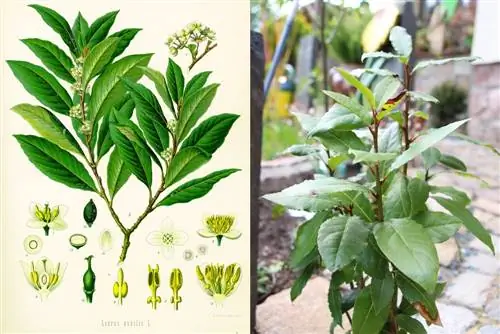
Spice laurel does not tolerate high temperatures below zero. In the short term -10°C can be tolerated (if the location is good and conditions are ideal), but in the long term temperatures below -5°C are very unfavorable. Planted specimens often freeze on the surface in winter. With a bit of luck, the rootstock will survive and sprout again in the spring. But it shouldn't be cold for very long, nor should the temperatures plummet. It is very unfavorable if the debilitating conditions repeat themselves every winter. The plants usually don't survive.
- No temperatures below -5°C
- Because it is evergreen, it needs to be watered every now and then
- Don't water too much!
Bucket keeping
The vessel should remain outdoors for as long as possible. This is how the laurel is hardened. Temperatures down to -5°C are ok. For very young plants, start a little earlier and lower the temperatures by 1 to 2 °C every year. The conditions in a cold house are ideal, but unfortunately only a few have this. Since the plants are evergreen, they require sufficient light. A cool room is also important. 5°C is completely sufficient. If the spice laurel is to overwinter outdoors, the container must be wrapped up warm. You should also place it on some Styrofoam plates. A very sheltered place is important, a warm corner in front of a house wall would be good.
- Temperatures around +5°C
- Brighten
- Not too warm
Planted spice laurel must be planted very protected. In addition, the root area should be packed thickly. Straw, leaves or something similar are used, which are then weighed down and covered with a layer of brushwood. This protects the bale and also prevents the ground from being too wet. It is important to cover the leaves in frost and sunshine. In this case, a gauze or something similar prevents too much water from evaporating in the sun. Because the ground is frozen, the laurel cannot absorb water and dries up.
- Protect root balls from cold and moisture
- Cover laurel in sun and frost
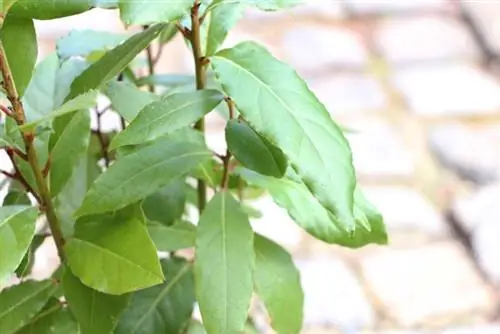
Propagation of spice laurel
Spice laurel can be propagated in various ways, by sowing, cuttings and cuttings. All three types are easy to do. When sowing, it is important to let the seeds soak in warm water for a day. By the way, it can be done all year round. The seeds are placed in potting soil and covered with about 1 cm of soil. It is a good idea to cover the container with glass or transparent film to create a favorable climate for germination. The substrate should be kept evenly, slightly moist, but never too wet. Warm temperatures are ideal. To prevent mold from forming, it must be ventilated regularly, i.e. remove the glass or film. The germination time is around 3 to 9 weeks. After 5 to 8 weeks, the seedlings are transplanted. It is important not to put the young plants in the sun for the first few weeks, they are too tender and would burn.
- Sowing possible all year round
- Soak seeds
- sow 1cm deep
- Cover the container and keep warm
- Keep evenly slightly moist
- Air regularly
Head cuttings are cut in early summer. It is best to use half-ripe, i.e. only slightly woody, shoots. Remove the lowest leaves. Either you put the cuttings in potting soil that has been loosened with sand or in a peat-sand mixture. Here too, an appropriate microclimate is good, which is why a transparent bag should be placed over the planter. Ventilation is also very important here.
- Semi-woody cuttings in early summer
- Use in potting soil or a peat-sand mixture
- Put the bag over it
- ventilate
- Keep moist and warm
In order to get offshoots, a shoot of the spice laurel is carefully bent in March or April so that it lies on the ground. It is ideal to attach it to the floor with a small hook. Alternatively, you can also place a stone on top. Cover the place where the shoot touches the ground with soil. Rooting can take a long time. You can tell whether it worked if new shoots and leaves form. Then the connection to the mother plant can be broken. Insert the new plant separately.
- March to April
- Bend the shoot to the ground
- Moor and cover with earth
- Keep moist
- May take a long time
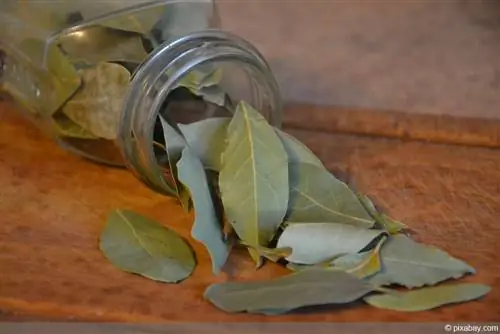
Diseases and pests on spice laurel
The spice laurel is a robust and usually very he althy plant. Most pests don't like the essential oils and avoid the tree. If any occur, they usually occur during the winter when it is too warm. Then spider mites or other sucking insects tend to spread. If possible, the room temperature should be lowered and the humidity increased.
Harvesting Spice Laurel
Mainly the leaves are harvested. If the trees also bear berries, these can also be used. If you value a lot of essential oil in the leaves, you should harvest in spring or autumn. Individual leaves can be cut from the tree at any time. They are used fresh or dried. Fresh leaves have a more intense aroma than dried ones, but taste too bitter for many people. The bitter substances evaporate when drying, but the aroma also evaporates.
Conclusion
A spiced laurel is the ideal container plant. The tree looks good and provides leaves and berries for the kitchen. Care is easy, but wintering is a little more complicated. An unheated winter garden or cold house is ideal. In winters that are often no longer so cold, the plants also survive outdoors. However, when keeping in a bucket, care must be taken to ensure that the container does not freeze.


